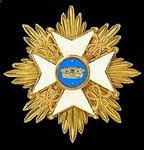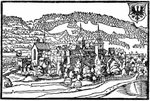
 I am grateful to Christian Rogge for taking time from his busy life to translate text for me from Wolfgang Friedrich's Uniformen der Kurfürstlich Sächsischen Armeen 1683-1763 - Selbstverlag Arbeitskreis Sächsische Militärgeschichte e.V Dresden, 1998 on the Saxon chevaulegers. This allows me to portray the Regiment Prinz Karl as described by Friedrich; note the different cuff detail and the button fastening the turnbacks. Otherwise this is very close to the previous version I have posted here, which was based very much on Schirmer as detailed by Pengel and Hurt.
I am grateful to Christian Rogge for taking time from his busy life to translate text for me from Wolfgang Friedrich's Uniformen der Kurfürstlich Sächsischen Armeen 1683-1763 - Selbstverlag Arbeitskreis Sächsische Militärgeschichte e.V Dresden, 1998 on the Saxon chevaulegers. This allows me to portray the Regiment Prinz Karl as described by Friedrich; note the different cuff detail and the button fastening the turnbacks. Otherwise this is very close to the previous version I have posted here, which was based very much on Schirmer as detailed by Pengel and Hurt.
Next, the other 2 chevaulegers regiments that fought with the Austrians, Graf Brühl and Prinz Albrecht, both with lapels, if I can reconcile all the petty differences of detail!
Wednesday, 8 July 2009
Trooper of the Saxon Chevauleger Regiment Prinz Karl Revisited
Posted by
David Morfitt
at
Wednesday, July 08, 2009
5
comments
![]()
Sunday, 5 July 2009
Trooper of Bavarian Hohenzollern Dragoons

 Impoverished by years of war during the War of the Austrian Succession, Bavaria had to make severe cutbacks and the army was reorganised in the 1750s. The 4 cavalry regiments, 2 regiments of cuirassiers and 2 of dragoons, were very much below strength - at the beginning of the SYW there were 1190 men and only 270 horses all told. The cavalry took no part in the SYW.
Impoverished by years of war during the War of the Austrian Succession, Bavaria had to make severe cutbacks and the army was reorganised in the 1750s. The 4 cavalry regiments, 2 regiments of cuirassiers and 2 of dragoons, were very much below strength - at the beginning of the SYW there were 1190 men and only 270 horses all told. The cavalry took no part in the SYW.
Hohenzollern Dragoons, like the other regiments, had a theoretical strength of 9 companies with 38 men each, organised in 3 squadrons in wartime. Inhaber: GFM J. Fürst Von Hohenzollern. Commander: Freiherr Von Nagel. In garrison in Munich, then Scharding.
The colours of the shabraque are speculative but possible; they follow the same pattern as those of Preysing.
Posted by
David Morfitt
at
Sunday, July 05, 2009
4
comments
![]()
Musketeer of the Hamburg Infantry Regiment

 The Hanseatic cities of Hamburg, Bremen and Lübeck stayed out of the fighting during the SYW but they did have their own regiments of infantry. This is a musketeer of the Hamburg infantry regiment, around the beginning of the SYW. First raised 1690, it had 12 companies between 1695 and 1775. There was also a dragoon unit, one company strong between 1716 and 1811, plus an artillery corps.
The Hanseatic cities of Hamburg, Bremen and Lübeck stayed out of the fighting during the SYW but they did have their own regiments of infantry. This is a musketeer of the Hamburg infantry regiment, around the beginning of the SYW. First raised 1690, it had 12 companies between 1695 and 1775. There was also a dragoon unit, one company strong between 1716 and 1811, plus an artillery corps.
The only detailed information I have found on these troops is a Knötel plate; this gives the primary sources as an oil painting in the Hamburger Alterthumsmuseum ("Parade eines Theils der Garnison auf dem Grossneumarkt"), large wooden figures, weapons, etc. (Knötel thanks Thomas Muhlsfeldt in Hamburg for the information). If anyone has further information I'd be very interested to know more. Does anyone know if the Hamburg material survived the horrors of World War Two?
Posted by
David Morfitt
at
Sunday, July 05, 2009
0
comments
![]()

















